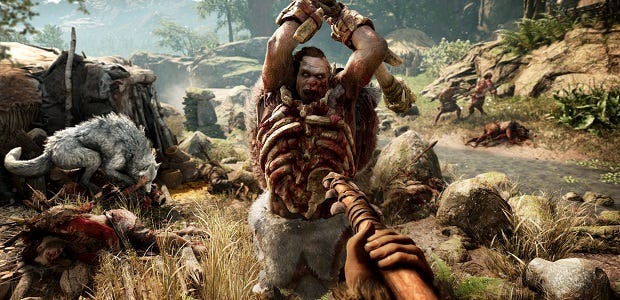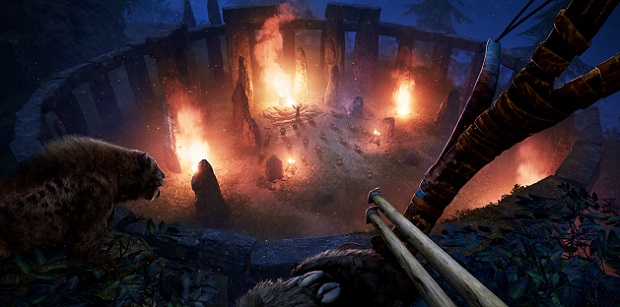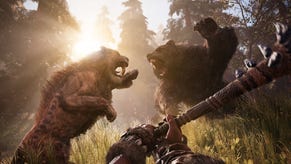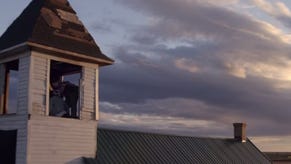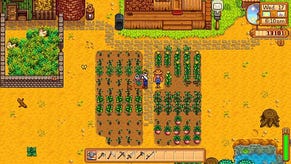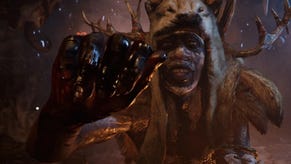Hands On: Far Cry Primal
The Bear Necessities
Far Cry Primal is skulking around in the development undergrowth, waiting for the right moment to strike. We sent Brendan to observe its behaviour.
I wasn't sure if many players would enjoy the Stone Age setting of the new Far Cry, then I saw a man from my tribe taking a painful dump behind a tree in the middle of our settlement, and I decided to give it the benefit of the doubt. This is the village of the Wenja, one of three tribes who fight it out in the world of Oros for territory and resources. The story centers on your cave man character, Takkar, as he rebuilds his people from their scattered remnants after a long ice age. There are no explosions in the year 10,000 BC, but you do get to ride around on the back of a sabretooth tiger, so there's always that.
I got to play the first three hours of the game, more or less, which saw me through a lot of the introductory fluff. A lot of it was Far Cry basics but there were plenty of curve balls along the way. The kind of small, incremental changes that Ubisoft weld onto their blockbuster follow-ups. It was like visiting your hometown after years away. Everything was different, but also kind of the same.
Let's look at attacking outposts first. That has always been the main draw of the series since Far Cry 3 revamped things with Jason "Murder Is Hilarious" Brody. In Primal, the built-up guard posts, alarm systems and machinegun nests are replaced with the wood, stone and clay encampments of enemy tribes - the cannibalistic Udam or the fire-worshipping Izila. Clearing out a camp and lighting a bonfire unlocks the place as a fast travel destination and recruits more Wenja to your tribe. That old satisfaction of skulking around, tagging enemies and getting a good vantage point before you strike is all still there, albeit in a slightly more overgrown environment, sans sniper rifle.
Like I say, it feels both different and the same. You can still tag enemies by peering at them down the "barrel" of your arrow shaft and so forth, granting them a revealing shadow from behind cover (you have to unlock this skill but it is available quite early). Yet you can also summon an owl to survey the land from above and tag the enemies this way. In this mode you become the owl, controlling it as it circles the area, open-eyed, focused and wise, entertaining a calm approach to neolithic reconissance. Also, this owl is psychotic. You can swoop down and kill a man, which then wrenches control back to Takkar, and according to some trailers (because I didn't see this ability myself), the owl will eventually be able to drop fire bombs on people.
Lots is being made of the animals and the control you will have over them. This "Beast Mastery" allows you to conjure up an array of predators from the bush. White wolves, black wolves, bears, white tigers, sabretooths, jaguars, dholes. You have to "tame" them first by discovering one lurking in the wild and throwing bait down. Then, as it feasts, you have to approach slowly and say "shhhh" at it until it doesn't want to destroy you. This takes the form of holding down a button until the slavering animal becomes chilled out. There's no minigame, either cumbersome or enjoyable, aside from approaching the beast quietly. After that's done, they'll potter around at your side and I can gladly report the animals never got in my way a la Dogmeat, not once.
I didn't get to tame or summon any honey badgers or mammoths but I am informed they will make an appearance. Later skills will open up these new animals and other abilities but early command of the beasts was limited to pointing at an enemy and whistling a command for them to attack, which they would do in a much bloodier fashion than Diamond Dog. They can be hurt and become incapacitated, at which point you have to go and revive them with a meat snack. Then, they'll carry on rampaging. I can confirm that I was able to pet my wolf sidekick after each murder.
The human enemies still come in different classes, the ugg-ugg equivalent of past henchmen.There are archers who keep their distance but still slash you with a knife if you get too close, club-wielders who charge you down as fast as possible, and spearfolk who raise their spear arms and aim throws with careful malice. There are feisty little dudes who throw poison at you in clay pots and the "heavies" (those represented by the shield symbol) are overwhelmingly strong and uh... "arrow spongey"? Yeah, sure, let's go with that. They're arrow spongey. I tried to take one of these fellas head-on and I had to call in a bear just to deal with him while I hid down a big hole.
As for your own arsenal, I'm afraid I didn't get very far with unlocking weapons. You begin the game with a short bow and soon progress to a club. You can set fire to your arrows and the head of your club pretty much from the start of the game, which makes for a lot of burning, flailing enemies. Fire itself is a central weapon as so much of the terrain is flammable. One mission charged Takkar with setting fire to an entire village of an enemy tribe, which I did in the most barbarian way possible, plodding around and cruelly thrusting my firelit club into the thatch of huts and watchposts. Later, I unlocked a Longbow, a spikier club, and the ability to hold more than two spears at a time. Limited "ammo" isn't such a problem though - you can remake anything on the hoof, even in the middle of a fight, just by holding down a dedicated crafting button. So long as you have the resources.
Although the outpost attack is still clearly the main attraction, there are some small departures from the norm. There is no "climb the high thing, reveal the map", for instance - a merciful retirement of an Ubisoft cliché that consistently invites mockery. In its place, you simply reveal the map around you as you go, like the "shroud" of an old-fashioned RTS. You can unlock skills which increase the radius around you that cleans away this darkness. I don't know if this is an improvement or a throwback, but it makes sense in terms of the setting - Stone Age people would probably learn their surroundings by sight and landmarks, not with advanced point-of-reference cartography. And anyway it's a relief Ubi have done something different. You know what they say: "A change is as good as not having to climb 40 slightly-different towers."
Then there is your tribe's home settlement. This is a village that acts partly like the mission hubs of previous games but also as a physical representation of the passive skills and abilities you unlock. You can bring back resources to build and upgrade the huts of special characters. Upgrading the Shaman's hut for example, will let you tame more dangerous animals and unlock the skills needed to control them. Upgrading the hut of your tribe's matriarchal leader let's you craft new food recipes from meat and herbs. This takes the place of the last game's buffing syringes. Everything your character can do is connected to the state of your home village, which fittingly means there's always some hunting and gathering to do.
Thankfully, it looks like there's not too much of a collector's burden on the player, as "rewards stashes" appear in outposts and in your home settlement, which generate materials and resources over time, and there are skills that increase how bountiful these stashes can become. A special mode of sight, called "beast vision" or "hunter's vision" or "murder vision", I can't remember which, highlights the materials you can gather, as well as enemies, animals and any tracks you are able to follow during missions.
To step away from the bits 'n' pieces for a moment, something I found interesting was the decision to create a language for the Wenja and the other tribes. This is based on Proto-Indo-European, the developers say (see interview below). Besides being an impressive detail, it makes sense. More so than having the cave peeps hollering at each other in modern English or French, for instance. But something about it still threw me off. Maybe it was having to read subtitles while there was action going on. Maybe it was simply the way their sentences read, with everyone leaving out their determiners and prepositions, like giant baby people. I don't know. It might turn out to be more fun just turning the subtitles off and trying to figure out what's happening from context.
This small niggle about the writing reminded me of The Inheritors by William Golding (don't panic! I will get back to the game soon). It's a book about a group of Neanderthals trying to survive in the burgeoning shadow of homo sapiens. The idea of an ancient people and the mystery of how they lived, talked and acted is super interesting to me. But it's the execution that matters. I didn't finish that book in the end, because the characters were so intellectually distant from anything I knew, and everybody spoke in such a primitive way that it became difficult for me to relate to them or care about them as people. I have a small concern that the same could be said for Takkar and the Wenja. On the other hand, if somebody in The Inheritors had regularly stomped around on the back of a mastadon and impaled the homo sapiens with flame-tipped spears, maybe I would have finished it. Ubisoft 1 - William Golding 0.
That aside, Far Cry Primal appears to be made of a strange yet familiar mould. There are patrols of friendly Wenja, as well as enemies, and side missions to free prisoners or kill tribal chieftains pop up while you travel. There was at least one "Shaman Vision" when I played, threatening dreamlike sequences that will replace the Shangri-La sections of Far Cry 4. What Primal doesn't appear to be is a survival game. It doesn't share any of the DNA of its survivalist cousins such as Ark: Survival Evolved, apart from in appearance. And (let's run with the evolutionary metaphor here until we die) on the tree of life it is still obviously far more closely related to its direct predecessors.
A day and night cycle means that moving from place to place will be more difficult after dark, requiring firelight to navigate in a wilderness of savage nocturnal beasts. But there is no cold meter or sleep meter to worry about, or none that I could notice. No ill effects from wandering around without eating for the whole day. There are campfires with furs rolled out like sleeping bags next to them, but lighting one of these fires just unlocks a fast-travel marker and taking a nap under the covers simply offers the player the chance to fast-forward time to either dawn or sunset. This distancing itself from the mechanics of true survival games is either going to disappoint you or make you breathe a sigh of relief. Just know that, whatever your tastes, the creators are not messing with the formula too much here. Not that anyone should be surprised at that. Let's face it, non-numbered spin-off or not, this is one of Ubisoft's core series.
Perhaps most importantly for the world of Primal, there are still moments of silly happenstance. As I was playing, I set a giant cave bear on fire and watched as it ran for hundreds of metres, spreading the flames everywhere it went. Eventually, the fire on the bear's fur went out, and it started chasing after some wolves because... I don't know, because it was cranky? Meanwhile, I was surrounded by a small forest fire. There's an Aesopian moral in this anecdote somewhere but I'm not sure if I have the energy to find it. "Don't set bears on fire"?
And maybe that is all Primal needs to successfully pounce on Far Cry fans come the 23rd of February (or March 1st for us in the PC tribe). There is a part of me, I can't deny it, that missed all the explosions and helicopters of Kyrat, or the presence of a well-acted villain like Michael Mando's Vaas (Primal's main baddie, a bloodied cannibal called Ull, did nothing for me in my short time with him). But there's another part of me, more primitive perhaps, that laughed when that constipated cave man pooped behind the tree in our village, and that relished creeping up on a trio of feasting cannibals and siccing a white tiger on them.
After the fight, I heard a crunching sound. When I turned around, the tiger was eating one of the corpses. Savage, gory and a little silly. That sounds like a Far Cry game to me.
Q & A: Thomas Simon, Game Director
RPS: I guess my first question is: why 10,000 years BC?
Thomas Simon: We'd say: why not? For us it's really the perfect set up and context for Far Cry. It's the first frontier, the first time man starts to fight over territory. It offers a beautiful landscape and dangerous wildlife and that's all the stuff we are looking for in Far Cry.
And actually, the idea was present within the team even at the time of Far Cry 3. Some people were talking about that, they found it interesting as an idea.
RPS: Are you worried about taking away the player's toys? Things like the wingsuit, the guns, the technology that we have gotten used to?
Simon: When we created the game we didn't proceed by emulation, we really decided to explore what made sense at the time... so there are some choices that we have to make, to make the game believable but at the same time we want to give the same kind of freedom with the toys and the tactical opportunities we had in previous games, so we explore other kinds of weapons. That's where we came up with the idea of controlling beasts, that's something that's new, that we didn't have before on this scale.
You haven't seen it yet but you will be able to ride some of those predators, you can ride the sabretooth or the bear. We created different types of bows, spears, one-handed club, two-handed club, poisonous weapons, we reformed the use of fire - all of those to create the same kind of tactical freedom and playstyle the player [will] have experienced.
RPS: With those beasts and animals, was that a case of seeing what people liked in previous games and developing that?
Simon: Actually what happened was that we knew from the beginning of the game we wanted to put a strong focus on the hunting, and the relationship with animals. We realised there are a lot of spectacular animals that you have not necessarily seen when playing another Far Cry... The idea of 'Beast Mastery' came a little later when we tried to reform the set of tools for the player. The starting point was to really try to put the animal at the core of the experience, really give the player that authentic feeling of not being in a man-ruled world but in an animal kingdom.
RPS: And the people in the tribes - what kind of story are you trying to tell with the different tribes? Am I right in thinking some of them are neanderthals and some "modern humans"?
Simon: So actually, all tribes are really sapiens, they're really 'contemporary man' tribes but they have really suffered and evolved differently through the recent centuries of the Ice Age. The Udam tribe were stuck in the North of Europe and suffered a lot from the Ice Age. They really had to use extreme measures to survive. They had to rely on cannibalistic practices, inbreeding to survive and it basically brought their tribe to the brink of extinction. When they arrive in Oros they are really trying to survive and save their tribe, so they do it by conquering territories, by eating and killing other tribes.
The Izila, they are more advanced but they are really the same species of human. They have started to practice agriculture, so we change a bit of their behaviour, their habits. They have started to settle, to establish religious sites permanently in the world... but in the end it is really a conflict between men of the same species that just have evolved very differently and have very different motivations.
RPS: The language that they use is not recognisable at all. How was that decided and developed?
Simon: Again, for authenticity. We wanted to bring the experience of being in the stone age to the point where the player would really feel involved in it and langauge would break the experience or the believability if we did not adapt it to the context. We decided, with the help of experts, to recreate three different languages based on the Proto-Indo-European language which is the mother of all tongues for Europe, for Russian... it goes into Latin, et cetera. So there's a lot of words that, when you start exploring them, you realise are reminding you of something you know and that was quite an exciting adventure. I think it brings a lot to the authenticity of the game and to the immersion to the world of being a Stone Age hunter.
RPS: How do you think the player is going to relate to the Wenja, the tribe that they play as? How is their story going to unfold and keep the player's attention?
Simon: The story is really around Takkar, so the player is discovering Oros, trying to bring back all the Wenja together. It's a journey from survival to apex predator that you will experience. This is going to be your story. When doing so you're going to cross the paths of the other tribes. The Wenja tribe is the tribe of your old cousins, they are the one you can relate to, they are hunter-gatherer, they are a bit nomadic, you can experiment with them the first time that they settle permanently. They have shamanic belief, they are more in relation with nature which will go really well with your relations with animals and the fact that you can dominate and tame them. Those come together with the Wenja tribe and they blend with your own story.
RPS: Thanks for your time.
Far Cry Primal is released on PC on 1 March.
